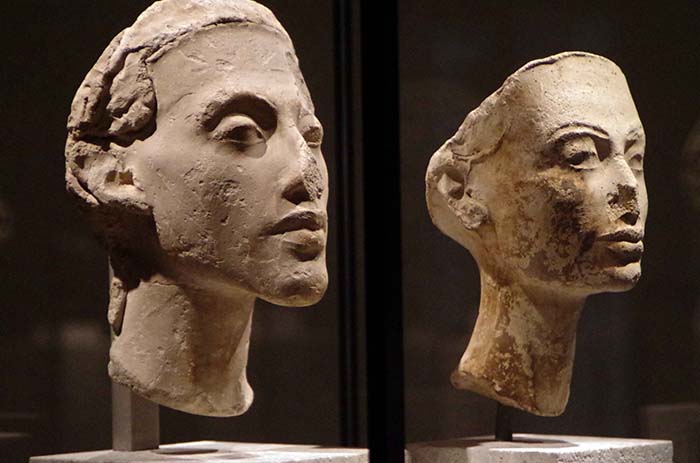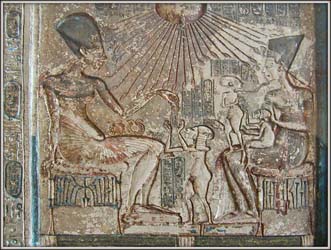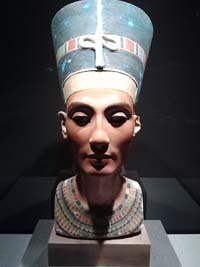Nefertiti
Nefertiti was the wife and queen of Pharaoh Akhenaten. They were members of the 18th Dynasty and ruled during the New Kingdom Period. Nefertiti was queen during a period of great financial wealth and religious upheaval.
Nefertiti's husband abolished the state worship of the old gods and instituted a new national god, Aten. Nefertiti played an important role in the worship of Aten and in her husband’s religious ideas. The bust of Nefertiti in the Berlin Museum shows her as a beautiful woman and has made her Egypt’s most recognizable queen.
Who was Nefertiti?
On the surface, this seems like an easy question to answer. Nefertiti was the queen of Egypt, the wife of Akhenaten, the mother of six of his children and a major part of Aten’s worship. However, no one knows where Nefertiti came from. Several different theories about her origins exist today.

© Damian Entwistle - Nefertiti worshiping Aten
One theory put forth by early Egyptologists was that Nefertiti was a foreigner, possibly having brought the ideas of Monotheism with her from another country. Having been one of the foreign princesses in Amenhotep III’s harem, she married Akhenaten, then changed her name to Nefertiti. Most modern scholars reject this theory because there is no archaeological evidence to support it.
Another theory speculates that Nefertiti was the daughter of Amenhotep III and one of his lesser wives. Most scholars reject this theory because the title “King’s Daughter” was not used to refer to her. Female royals gained their prestige from their relationship with the king, using the name of “King’s Daughter” as part of their titles. Since Nefertiti did not use this title, she was most likely not a royal princess.
The final theory suggests that Nefertiti was a member of the Egyptian elite. This idea has precedence because Akhenaten’s mother, Tiy, was a non-royal and a member of the Egyptian elite. Discovering the identity of Nefertiti’s parents has proven difficult. Only one person who was not a member of the royal family claimed familial ties with her, Mutnodjmet, her younger sister.
Male relatives of the queen did not claim familial ties with her in their funerary texts. The grave of Yuya, Tiy’s father demonstrates this fact. Women did claim ties with the queen, as shown by Tiy's mother's tomb, although scholars have not found the tomb of Nefertiti's mother.
One woman, Tey, claimed to be the queen’s wet nurse and her husband was Ay, Queen Tiy’s brother. Some scholars have speculated that Tey was Nefertiti’s stepmother and Ay was her father. No evidence has come to light that can solve this question or prove any theory.
Akhenaten and Nefertiti
All the images of Akhenaten and Nefertiti show them as a devoted couple. Despite this, Akhenaten followed the example of other pharaohs in keeping a harem. Akhenaten and Nefertiti had six daughters; the existing images imply that they never had a son. Three of their daughters were born in Thebes: Meritaten, Meketaten and Ankhesenpaaten. The other three (Neferneferuaten-the-younger, Neferneferure and Setepenre) were born in Amarna.

© Mike Steele - Sculptures of Akhenaten and Nefertiti
Amarna and Aten
Nefertiti played an important part in Aten’s worship. Images show her making offerings to the Aten, a role which was usually reserved for the pharaoh.
Scholars believe that Akhenaten began instituting the worship of Aten during the third year of his reign. He first built temples at Karnak in Thebes. Later pharaohs destroyed all these temples and used their blocks as fillers for some of the great temple pylons at Karnak. Scholars have put together some of the frescoes (wall paintings) from these temples.
Some of these blocks came from a temple where most of the images show Nefertiti conducting rituals. The restored images show the queen and some of her daughters making sacrifices. Scholars have noted that the queen was participating in activities that only the pharaoh was usually shown doing. The restored images imply that the worship at this site was conducted by women.

© tutincommon - Depiction of Nefertiti at Amarna
The Egyptians were used to Triads of deities that often consisted of a god, a goddess and their child. Akhenaten pictured Aten as a remote creator/sustainer god and saw himself and Nefertiti as a semi-divine couple tied to the him. The three of them made up the Amarna equivalent of a divine Triad.
The abolishment of the worship of the older gods broke the power of the older priesthoods. Instead of looking to the priests to communicate with the god, the people looked to Nefertiti and Akhenaten. Tomb inscriptions at Amarna included prayers asking the pharaoh and Nefertiti for help. The people expected Nefertiti to intervene with her husband on their behalf.
Nefertiti took part in the worship of Aten at Amarna. Images show her making offerings to Aten by herself or with her husband. Often, the images show one or more of her daughters helping Nefertiti make offerings. The queen also took processional trips through the city with her husband and children.

© Jean-Pierre Dalbéra - Nefertiti and her family
Images of Nefertiti
Images of Akhenaten and Nefertiti are different than those of other pharaohs. During the Amarna period, the pharaoh and other people were not idealized with perfect features and bodies. Modern viewers should not think that the images and statues were portraits of Akhenaten and Nefertiti. Nefertiti’s bust implies that the queen was a beautiful and regal woman.
These portraits also show the king and queen in private settings with their children. They are playing with the girls and kissing them. Some depictions show all six girls with their relative ages implied.

© David Holt - Akhenaton and Nefertiti with their daughters
End of the Amarna Period
Around the 13th year of Akhenaten’s reign, major changes took place in the royal family. Several of the royal women disappear from the records in a short period of time. One of them was Queen Nefertiti. To date, scholars have found no definitive evidence revealing her fate.
This makes it difficult to write her biography, but some theories about her fate exist. The first is that she also died, but no records of her death exist and scholars have not found Nefertiti’s tomb. Another theory, that does not have a lot of support, says that she rebelled against Akhenaten and he banished her.
The last theory suggests that Nefertiti went into semi-retirement. Her oldest daughter, Meritaten, replaced Nefertiti in Aten's worship and as queen. Meritaten was the wife of her father’s heir, Smenkhkare. Some scholars think this change took place because Nefertiti could no longer bear children. Her role in Aten’s worship was as a sign of fertility and she was no longer fertile.
Nefertiti Facts
- Nefertiti was the wife of Akhenaten.
- No records exist of her origins or her ultimate fate.
- Nefertiti had six daughters, two of whom might have been queens of Egypt.
- Thanks to her bust in the Berlin Museum, Nefertiti is one of the most famous of Egypt’s queens and renowned for her beauty.
- Nefertiti played an important part in Aten’s worship.
- She was an integral part of her husband’s religious ideology.

